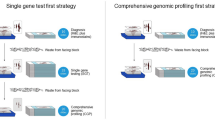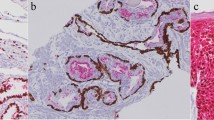Abstract
Background
This study elucidates the clinical impact of surgical treatment of head and neck squamous cell carcinoma (HNSCC) based on a detailed search of all exons of the TP53 gene and p53 protein phenotypic analysis using formalin-fixed paraffin-embedded (FFPE) specimens.
Methods
Clinically well-annotated FFPE specimens from 317 patients with HNSCC treated by surgery were examined by all-exon TP53 sequencing using a next-generation sequencer and p53 protein phenotype by immunohistochemistry. After excluding human papillomavirus-associated oropharyngeal carcinomas, two risk categories were classified as “p53 adverse function” and “p53 favorable function” based on TP53 mutation status and p53 protein phenotype. Mutation in PIK3CA, AKT, and HRAS was also evaluated by target sequence. Cox proportional hazards regression models were used for statistical analysis of clinical outcomes. Receiver operating characteristic curve analysis was used to determine the optimal surgical margin cutoff for local recurrence. Local control rates were compared between the risk groups using Fisher’s exact test.
Results
Multivariate analysis identified “p53 adverse function” as an independent poor predictor of overall survival, local control, and distant metastasis-free survival. In oral cavity cancer, the optimal surgical margin cutoff associated with local recurrence was 6 mm. In patients with surgical margin > 6 mm, the “p53 adverse function” group demonstrated significantly higher local recurrence rate than the “p53 favorable function” group. PIK3CA, AKT, or HRAS mutation did not correlate with improved overall survival.
Conclusions
All-exon TP53 sequencing and p53 protein phenotype analysis using FFPE specimens can accurately predict clinical outcomes.



Similar content being viewed by others
References
Agrawal N, Frederick MJ, Pickering CR, et al. Exome sequencing of head and neck squamous cell carcinoma reveals inactivating mutations in NOTCH1. Science. 2011;333:1154–7.
Stransky N, Egloff AM, Tward AD, et al. The mutational landscape of head and neck squamous cell carcinoma. Science. 2011;333:1157–60.
Cancer Genome Atlas Network. Comprehensive genomic characterization of head and neck squamous cell carcinomas. Nature. 2015;517:576–82.
Brosh R, Rotter V. When mutants gain new powers: news from the mutant p53 field. Nat Rev Cancer. 2009;9:701–13.
Neskey DM, Osman AA, Ow TJ, et al. Evolutionary action score of TP53 identifies high-risk mutations associated with decreased survival and increased distant metastases in head and neck cancer. Cancer Res. 2015;75:1527–36.
Zhang B, Wang J, Wang X, et al. Proteogenomic characterization of human colon and rectal cancer. Nature. 2014;513:382–7.
Vogel C, Marcotte EM. Insights into the regulation of protein abundance from proteomic and transcriptomic analyses. Nat Rev Genet. 2012;13:227–32.
Melhem MF, Law JC, el-Ashmawy L, Johnson JT, Landerneau RJ, Srivastava S, Whiteside TL. Assessment of sensitivity and specificity of immunohistochemical staining of p53 in lung and head and neck cancers. Am J Pathol. 1995;146:1170–7.
Marur S, D’Souza G, Westra WH, Forastiere AA. HPV-associated head and neck cancer: a virus-related cancer epidemic. Lancet Oncol. 2010;11:781–9.
Poeta ML, Manola J, Goldwasser MA, et al. TP53 mutations and survival in squamous-cell carcinoma of the head and neck. N Engl J Med. 2007;357:2552–61.
Boyle DP, McArt DG, Irwin G, et al. The prognostic significance of the aberrant extremes of p53 immunophenotypes in breast cancer. Histopathology. 2014;65:340–52.
Yemelyanova A, Vang R, Kshirsagar M, Lu D, Marks MA, Shih leM, Kurman RJ. Immunohistochemical staining patterns of p53 can serve as a surrogate marker for TP53 mutations in ovarian carcinoma: an immunohistochemical and nucleotide sequencing analysis. Mod Pathol 2011;24:1248–53.
Alsner J, Jensen V, Kyndi M, Offersen BV, Vu P, Borresen-Dale AL, Overgaard J. A comparison between p53 accumulation determined by immunohistochemistry and TP53 mutations as prognostic variables in tumours from breast cancer patients. Acta Oncol. 2008;47:600–7.
van Houten VM, Leemans CR, Kummer JA, et al. Molecular diagnosis of surgical margins and local recurrence in head and neck cancer patients: a prospective study. Clin Cancer Res. 2004;10:3614–20.
van Houten VM, Tabor MP, van den Brekel MW, et al. Mutated p53 as a molecular marker for the diagnosis of head and neck cancer. J Pathol. 2002;198:476–86.
Looser KG, Shah JP, Strong EW. The significance of “positive” margins in surgically resected epidermoid carcinomas. Head Neck Surg. 1978;1:107–11.
Chen TY, Emrich LJ, Driscoll DL. The clinical significance of pathological findings in surgically resected margins of the primary tumor in head and neck carcinoma. Int J Radiat Oncol Biol Phys. 1987;13:833–7.
Loree TR, Strong EW. Significance of positive margins in oral cavity squamous carcinoma. Am J Surg. 1990;160:410–4.
Garzino-Demo P, Dell’Acqua A, Dalmasso P, et al. Clinicopathological parameters and outcome of 245 patients operated for oral squamous cell carcinoma. J Craniomaxillofac Surg. 2006;34:344–50.
El-Husseiny G, Kandil A, Jamshed A, et al. Squamous cell carcinoma of the oral tongue: an analysis of prognostic factors. Br J Oral Maxillofac Surg. 2000;38:193–9.
Pimenta Amaral TM, Da Silva Freire AR, Carvalho AL, Pinto CA, Kowalski LP. Predictive factors of occult metastasis and prognosis of clinical stages I and II squamous cell carcinoma of the tongue and floor of the mouth. Oral Oncol. 2004;40:780–6.
Weijers M, Snow GB, Bezemer DP, van dr Wal JE, van der Waal I. The status of the deep surgical margins in tongue and floor of mouth squamous cell carcinoma and risk of local recurrence; an analysis of 68 patients. Int J Oral Maxillofac Surg. 2004;33:146–9.
Hinni ML, Ferlito A, Brandwein-Gensler MS, et al. Surgical margins in head and neck cancer: a contemporary review. Head Neck. 2013;35:1362–70.
Cooper JS, Pajak TF, Forastiere AA, et al. Postoperative concurrent radiotherapy and chemotherapy for high-risk squamous-cell carcinoma of the head and neck. N Engl J Med 2004;350:1937–44.
Bachaud JM, Cohen-Jonathan E, Alzieu C, David JM, Serrano E, Daly-Schveizer N. Combined postoperative radiotherapy and weekly cisplatin infusion for locally advanced head and neck carcinoma: final report of a randomized trial. Int J Radiat Oncol Biol Phys. 1996;36:999–1004.
Shah JP, Cendon RA, Farr HW, Strong EW. Carcinoma of the oral cavity factors affecting treatment failure at the primary site and neck. Am J Surg. 1976;132:504–7.
Johnson JT, Barnes EL, Myers EN, Schramm VL Jr, Borochovitz D, Sigler BA. The extracapsular spread of tumors in cervical node metastasis. Arch Otolaryngol. 1981;107:725–9.
Feldman M, Fletcher GH. Analysis of the parameters relating to failures above the clavicles in patients treated by postoperative irradiation for squamous cell carcinomas of the oral cavity or oropharynx. Int J Radiat Oncol Biol Phys. 1982;8:27–30.
Mirimanoff R, Wang CC, Doppke KP. Combined surgery and postoperative radiation therapy for advanced laryngeal and hypopharyngeal carcinomas. Int J Radiat Oncol Biol Phys. 1985;11:499–504.
Peters LJ, Goepfert H, Ang KK, et al. Evaluation of the dose for postoperative radiation therapy of head and neck cancer: first report of a prospective randomized trial. Int J Radiat Oncol Biol Phys. 1993;26:3–11.
Acknowledgements
We acknowledge Yuki Saito, MD, PhD for his substantial contribution to critical manuscript revisions. The authors wish to thank Mr. Kensuke Suzuki (Illumina Inc.) for technical support. We also thank Ms. Sachiko Miura, Ms. Toshiko Sakaguchi, and Ms. Chizu Kina for skillful technical assistance.
Funding
This work was supported by Japan Society for the Promotion of Science (JSPS) KAKENHI Grant nos. 16K20232 to K.K. and 17K08710 to T.M.
Author information
Authors and Affiliations
Corresponding author
Ethics declarations
Disclosure
All authors declare that they have no conflict of interest.
Additional information
Publisher's Note
Springer Nature remains neutral with regard to jurisdictional claims in published maps and institutional affiliations.
Electronic supplementary material
Below is the link to the electronic supplementary material.
Rights and permissions
About this article
Cite this article
Kobayashi, K., Yoshimoto, S., Matsumoto, F. et al. All-Exon TP53 Sequencing and Protein Phenotype Analysis Accurately Predict Clinical Outcome after Surgical Treatment of Head and Neck Squamous Cell Carcinoma. Ann Surg Oncol 26, 2294–2303 (2019). https://doi.org/10.1245/s10434-019-07287-x
Received:
Published:
Issue Date:
DOI: https://doi.org/10.1245/s10434-019-07287-x




